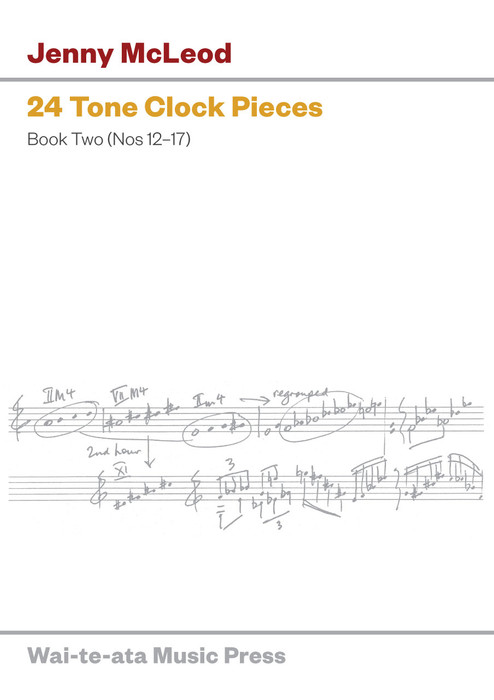Description:
The Tone Clock is a compositional technique developed initially by Dutch composer Peter Schat in the early 1980s. Schat, who was steeped in the serial tradition, noticed the way in which all possible three-note chords, with the exception of the diminished chord, can be transposed (and, in some instances, inverted as well) to generate all twelve chromatic notes once and once only—in geometrical terms, a ‘tessellation’.
Schat realised that in doing so, you create a strong sense of tonality despite the music’s essentially twelve-tone nature, as the inherent ‘intervallic flavour’ of the three-note chord shines through and colours the entire harmony of the piece. In chromatic theory, there are only twelve possible three-note intervallic groups, ranging from a chromatic cluster (two semitones) up to an augmented chord (two major thirds). Schat calls these twelve groups the ‘hours’, and they form the harmonic basis of most tone clock works.
Jenny McLeod’s contribution to tone clock theory was to take Schat’s basic idea and expand it out to encompass all of the 223 possible intervallic configurations of the chromatic system (known as ‘set classes’ or ‘prime forms’ in Allan Forte’s pitch-class set theory). In her monograph Chromatic Maps I & II, she brings a mathematical rigour and remarkable taxonomization to bear on the project, revealing a vast array of hidden properties of the chromatic system. She also provides a spectacular ‘Grand Unified Theory’ of almost all equal-tempered tonal and chromatic approaches, taking in conventional Western tonality, Messiaen’s modes of limited transposition, Webern’s ‘serial derivation’ and Boulez’s frequency multiplication.
It was in her Tone Clock Pieces, however, that she worked out the intricacies of tone clock theory in practice. While all twelve chromatic pitches are heard often, the particular intervallic qualities of the hours—sometimes open and quartal, sometimes close and clustered, often floating and fluid—give each Tone Clock Piece a distinct ‘aura’ or ‘perfume’. Furthermore, the inherent symmetries in tone clock theory imbue these pieces with a refractive brilliance and a shimmering haze of resonance
 Loading... Please wait...
Loading... Please wait...
